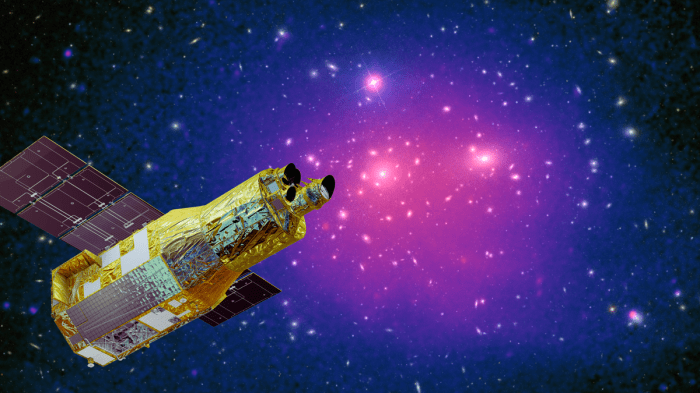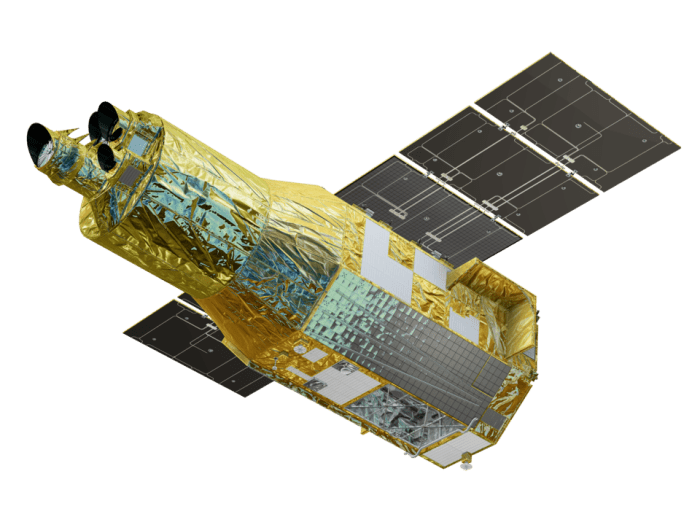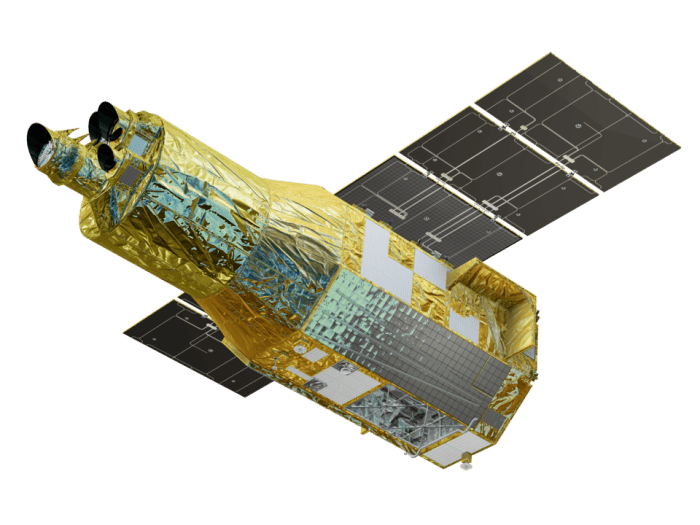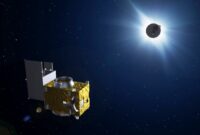X ray satellite xrism launching space – X-ray Satellite XRISM launching into space marks a pivotal moment in our quest to unravel the mysteries of the universe. XRISM, short for X-ray Imaging and Spectroscopy Mission, is a joint endeavor between Japan Aerospace Exploration Agency (JAXA) and NASA, poised to revolutionize our understanding of celestial objects and phenomena.
This groundbreaking mission will employ cutting-edge technology to capture unprecedented details about the universe’s most energetic and enigmatic regions.
XRISM’s primary objective is to study the hot, ionized gas that permeates the cosmos. By analyzing the X-ray emissions from this gas, scientists hope to gain insights into the formation and evolution of stars, galaxies, and black holes. XRISM’s instruments, Resolve and Xtend, are designed to provide high-resolution spectral and spatial data, enabling scientists to delve deeper into the intricate workings of the universe than ever before.
X-ray Astronomy and XRISM
X-ray astronomy is a crucial field that provides us with a unique perspective on the universe, revealing phenomena invisible to visible light telescopes. By studying the X-rays emitted from celestial objects, astronomers gain insights into the most energetic and extreme environments in the cosmos, from the births and deaths of stars to the supermassive black holes at the centers of galaxies.
XRISM Mission
The XRISM (X-ray Imaging and Spectroscopy Mission) is a joint mission between the Japan Aerospace Exploration Agency (JAXA) and NASA, designed to revolutionize our understanding of the high-energy universe. XRISM is equipped with two cutting-edge instruments:
- Resolve:A high-resolution X-ray spectrometer that will measure the energy of X-rays with unprecedented precision. Resolve will enable scientists to study the composition and motion of hot gas in distant galaxies, unraveling the processes that drive galaxy evolution.
- Xtend:A wide-field X-ray imager that will capture images of the sky in soft X-rays. Xtend will provide valuable data for studying the distribution of hot gas in galaxy clusters, the remnants of exploded stars, and the accretion disks around black holes.
Scientific Objectives of XRISM
XRISM’s scientific objectives are ambitious and encompass a wide range of research areas. Some of the key focuses include:
- Understanding the Evolution of Galaxies:By studying the hot gas in galaxy clusters, XRISM will shed light on how galaxies form and evolve over cosmic time. This research will help us understand the interplay between galaxies and their surrounding environments, and the role of dark matter in galaxy formation.
- Exploring the Physics of Black Holes:XRISM will observe the accretion disks around black holes, revealing crucial information about their properties and the mechanisms of accretion. This will contribute to our understanding of the fundamental physics of gravity and the behavior of matter in extreme environments.
- Investigating the Explosions of Stars:XRISM will study the remnants of exploded stars, called supernova remnants, to understand the processes that occur during these cataclysmic events. This research will provide insights into the origin of heavy elements in the universe and the evolution of stars.
- Mapping the Distribution of Hot Gas:XRISM’s wide-field X-ray imager will provide detailed maps of the distribution of hot gas in the universe, revealing the structure and evolution of large-scale cosmic structures.
XRISM’s Capabilities
XRISM’s advanced capabilities will enable it to address fundamental questions in astrophysics, such as:
- What is the composition of hot gas in galaxy clusters?XRISM’s high-resolution spectroscopy will allow scientists to identify the elements present in this gas and measure their abundance, providing insights into the processes that have enriched the gas with heavy elements.
- How do black holes accrete matter?By studying the accretion disks around black holes, XRISM will reveal the mechanisms that govern the flow of matter towards these enigmatic objects.
- What are the properties of supernova remnants?XRISM will provide detailed information about the temperature, density, and composition of supernova remnants, helping us understand the physics of these explosive events.
- How does the distribution of hot gas evolve over cosmic time?XRISM’s wide-field X-ray imager will provide crucial data for studying the evolution of large-scale cosmic structures, revealing how the distribution of hot gas has changed over billions of years.
XRISM’s Instruments and Technologies: X Ray Satellite Xrism Launching Space
XRISM is equipped with two cutting-edge instruments, Resolve and Xtend, designed to unravel the mysteries of the hot and energetic universe. These instruments, working in tandem, will enable groundbreaking observations in X-ray astronomy.
Resolve: A High-Resolution Spectrometer, X ray satellite xrism launching space
Resolve is a high-resolution X-ray spectrometer, the heart of XRISM’s scientific mission. It is designed to capture the subtle variations in the energy of X-rays emitted from celestial objects. This information allows astronomers to precisely determine the temperature, composition, and motion of these objects.
- Resolve’s ability to measure the energy of X-rays with high precision is crucial for understanding the physics of hot and energetic phenomena in the universe.
- It can distinguish between different elements and their ionization states, revealing the composition of distant galaxies, supernova remnants, and black holes.
- Resolve’s high spectral resolution allows astronomers to study the dynamics of these objects, such as the outflow of material from black holes or the shock waves generated by supernova explosions.
Xtend: A Wide-Field Imager
Xtend is a wide-field X-ray imager that complements Resolve’s capabilities. It is designed to capture a broader view of the X-ray sky, providing context for Resolve’s detailed observations.
Do not overlook the opportunity to discover more about the subject of the worlds first self driving bus fleet will soon hit scotlands streets.
- Xtend’s wide field of view allows astronomers to survey large areas of the sky, identifying interesting targets for Resolve to study in greater detail.
- It can detect faint X-ray sources, such as distant galaxies and clusters of galaxies, providing insights into the evolution of the universe.
- Xtend’s ability to image the X-ray sky with high sensitivity is essential for understanding the distribution and properties of hot gas in galaxy clusters.
Technological Advancements in XRISM
XRISM incorporates several technological advancements to achieve its scientific goals.
- One of the most critical technologies is the cryogenic cooling system, which maintains Resolve’s detectors at extremely low temperatures. This is essential for achieving the instrument’s high spectral resolution.
- XRISM also employs advanced X-ray optics, which focus the incoming X-rays onto the detectors with high precision. This allows for accurate measurements of the energy and direction of the X-rays.
- The spacecraft’s sophisticated pointing system ensures that XRISM remains accurately aligned with its targets, enabling precise observations over long periods.
Launch and Deployment

The launch of XRISM marked a significant milestone in X-ray astronomy. This ambitious mission, designed to unveil the mysteries of the universe, was meticulously planned and executed, ensuring a successful deployment into space.The launch of XRISM was a complex operation involving various elements, including the launch date, location, and launch vehicle.
The deployment process itself was equally intricate, with careful procedures for unfolding solar panels and antennas. The initial phases of the mission, including orbit and commissioning, were crucial steps in ensuring the smooth operation of XRISM.
Launch Details
XRISM was launched on September 7, 2023, from the Tanegashima Space Center in Japan. The launch vehicle used was the H-IIA rocket, a powerful and reliable launch system developed by the Japan Aerospace Exploration Agency (JAXA).
Deployment Process
Following its successful launch, XRISM underwent a series of deployment steps to ensure its readiness for scientific operations. This process involved:
- Unfolding of Solar Panels:The deployment of the solar panels was crucial for providing XRISM with the necessary power to operate its instruments and systems. The panels, designed to capture sunlight and convert it into electricity, were carefully unfolded and locked into position, ensuring a stable energy source for the mission.
- Deployment of Antennas:XRISM’s antennas, essential for transmitting data and receiving commands from ground stations, were deployed and aligned. This process involved carefully unfolding and positioning the antennas, ensuring optimal communication capabilities.
Initial Mission Phases
Once deployed in space, XRISM entered its initial mission phases, which included:
- Orbit Insertion:XRISM was placed into a specific orbit around Earth, allowing it to observe celestial objects from a vantage point that minimized interference from Earth’s atmosphere. The chosen orbit provided the optimal balance between observation time and data transmission capabilities.
- Commissioning:After reaching its designated orbit, XRISM underwent a rigorous commissioning phase, during which its instruments and systems were thoroughly tested and calibrated. This process ensured that all components were functioning correctly and that the spacecraft was ready to begin its scientific observations.
Scientific Observations and Discoveries

XRISM, with its cutting-edge instruments, is poised to revolutionize our understanding of the cosmos by providing unprecedented insights into some of the most enigmatic and dynamic objects in the universe. XRISM’s observations will unveil the secrets of black holes, illuminate the intricate workings of galaxy clusters, and shed light on the nature of the interstellar medium, the vast expanse of space between stars.
Black Hole Physics
XRISM’s high-resolution spectroscopy will allow us to study the accretion disks surrounding black holes in unprecedented detail. Accretion disks are swirling masses of gas and dust that spiral towards a black hole, releasing immense amounts of energy in the process.
By analyzing the X-ray spectra emitted by these disks, XRISM will reveal the physical conditions within them, such as temperature, density, and velocity. This data will provide crucial information about the dynamics of accretion and the processes that drive the extreme environments around black holes.
XRISM’s observations of black holes will allow us to test fundamental theories of gravity, such as Einstein’s theory of general relativity, in the most extreme environments in the universe.
Galaxy Cluster Evolution
Galaxy clusters are the largest known gravitationally bound structures in the universe, containing hundreds or even thousands of galaxies. XRISM’s sensitive X-ray detectors will allow us to map the distribution of hot gas within these clusters, revealing their intricate structure and evolution.
By studying the temperature and density of this gas, we can gain insights into the processes that drive the formation and evolution of galaxy clusters.
XRISM’s observations will provide a detailed picture of the distribution of dark matter within galaxy clusters, which is thought to make up the majority of the matter in the universe.
Interstellar Medium
The interstellar medium (ISM) is the tenuous material that fills the space between stars. XRISM’s observations will provide insights into the composition, temperature, and dynamics of the ISM, which plays a crucial role in the birth and evolution of stars.
By studying the X-ray emission from different regions of the ISM, we can learn about the processes that drive the formation of new stars, the evolution of existing stars, and the propagation of supernova remnants.
XRISM’s observations will allow us to study the role of cosmic rays in the ISM, which are high-energy particles that can significantly impact the physical and chemical properties of the interstellar gas.
Collaboration and International Involvement
XRISM is a testament to the power of international collaboration in space exploration and scientific research. This ambitious project has brought together a diverse group of scientists, engineers, and space agencies from around the world, each contributing their unique expertise and resources.
Participating Organizations and Their Roles
The success of XRISM is a direct result of the collaborative efforts of several key organizations:
- Japan Aerospace Exploration Agency (JAXA):JAXA serves as the lead agency for the XRISM mission, responsible for overall project management, spacecraft development, and launch operations.
- National Aeronautics and Space Administration (NASA):NASA provides the X-ray imaging spectrometer (XIS) instrument, a key component for studying the composition and temperature of celestial objects.
- European Space Agency (ESA):ESA contributes the Resolve instrument, a high-resolution X-ray calorimeter designed to measure the energy of incoming X-rays with unprecedented precision.
- Canadian Space Agency (CSA):CSA provides the calibration target for the XIS instrument, ensuring accurate measurements and data analysis.
- Other international partners:Several other institutions and organizations, including universities, research centers, and private companies, play vital roles in various aspects of the mission, such as instrument development, data analysis, and scientific research.
Importance of International Collaboration
International collaboration is essential for advancing space exploration and scientific research for several reasons:
- Sharing expertise and resources:By pooling their resources and expertise, participating nations can achieve goals that would be impossible for any single country to accomplish alone.
- Promoting scientific progress:Collaboration fosters the exchange of ideas, leading to innovative solutions and breakthroughs in scientific understanding.
- Strengthening global partnerships:International space missions like XRISM promote cooperation and understanding between nations, fostering a sense of shared purpose and global responsibility.
“XRISM is a shining example of how international collaboration can push the boundaries of scientific discovery and inspire future generations of scientists and engineers.”Dr. [Name of scientist], [Affiliation]
XRISM’s Legacy and Future Prospects

XRISM, with its advanced capabilities and ambitious scientific goals, is poised to leave a lasting legacy in the field of X-ray astronomy. Its observations will provide a treasure trove of data that will be analyzed and interpreted for years to come, advancing our understanding of the cosmos and inspiring future generations of scientists.
The Long-Term Scientific Value of XRISM’s Data
XRISM’s observations will contribute significantly to our understanding of a wide range of cosmic phenomena.
- The high-resolution spectroscopy of XRISM will allow us to study the composition and dynamics of hot gas in galaxy clusters, providing insights into the evolution of these massive structures.
- XRISM’s sensitivity will enable us to detect faint X-ray sources, such as distant galaxies and active galactic nuclei, shedding light on the early universe and the growth of supermassive black holes.
- The combination of XRISM’s high spectral resolution and sensitivity will allow us to study the atmospheres of exoplanets, revealing the presence of elements and molecules that could indicate the potential for life.
XRISM’s data will be a valuable resource for researchers for decades to come, providing new insights into the nature of the universe and our place within it.





